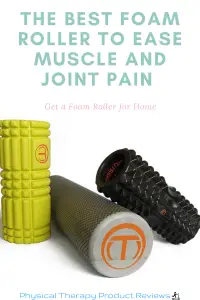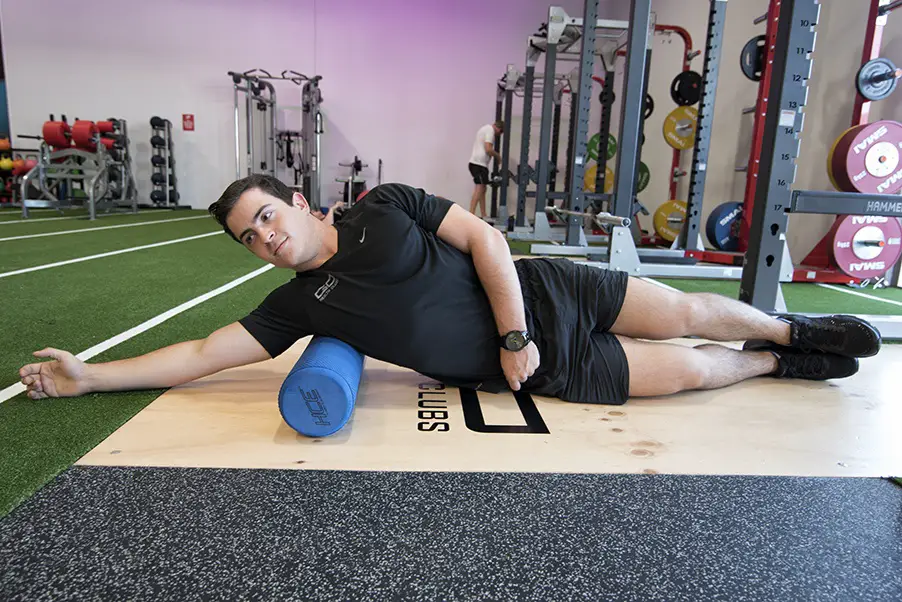Foam Rolling the Shoulder
 Foam rolling is a popular and common treatment used in physical therapy and other gym settings to improve muscle and joint pain. Foam rollers are most commonly used for lower extremity injuries but they be a great benefit for anyone with shoulder problems. A foam roller can help improve muscle tightness in the shoulder, help with strengthening exercises, and help improve the overall motion of the shoulder blade. It can be used in patients that have recently had surgery or as a post workout recovery tool. We share the best ways to use a foam roller to improve shoulder pain at home.
Foam rolling is a popular and common treatment used in physical therapy and other gym settings to improve muscle and joint pain. Foam rollers are most commonly used for lower extremity injuries but they be a great benefit for anyone with shoulder problems. A foam roller can help improve muscle tightness in the shoulder, help with strengthening exercises, and help improve the overall motion of the shoulder blade. It can be used in patients that have recently had surgery or as a post workout recovery tool. We share the best ways to use a foam roller to improve shoulder pain at home.
What is a Foam Roller?
A foam roller is made of high-density foam that is shaped into a long cylinder. The foam is made of varying densities and at different lengths. Most foam rollers are as long as 36” and the smaller ones as short as 12”. There are even foam rollers cut in half to make a half-cylinder.
The first foam roller was used in the 1980s by Physical Therapist Sean Gallagher as a form of self-myofascial release within the dance and athletic patient demographic. Since then foam rollers have been increasing in popularity in fitness, rehab, and sports settings across the globe.
To purchase a foam roller see our reviews on: The Best Foam Rollers for Muscle and Joint Pain. 
How Does a Foam Roller Work?
Foam rollers were originally designed to be a form of self-massage. The original goal was to lengthen muscles, fascia, and tendons as a form of self-myofascial release. We now know that this doesn’t actually happen and foam rollers do not perform myofascial release which has come into question in the latest research in regards to the actually proposed mechanisms of success. Rolling out fascia is not physically possible as fascia itself is incredibly strong. To stretch fascia even 1 mm it takes a significantly larger force than is humanly possible to achieve by rolling on foam.
Foam rolling actually works by influencing the central nervous system. By compressing the receptors within the muscles and skin, foam rolling causes the body’s nervous system to relax. This nervous system relaxing can cause a temporary decrease in muscle tightness, improvement in pain levels, and increased local blood flow to the target tissue. This gives the body the perception of less tightness and more mobility.
What are the Benefits of Foam Rolling?
Even though foam rolling doesn’t lengthen or stretch the fascia it still provides benefits that we can take advantage of.
- Increased localized blood flow to the muscles
- Improvement in pain pressure threshold
- Central Nervous System relaxation
- Acute improvement joint Range of Motion
- Reduction in post-workout soreness
The Best Foam Roller Exercises for Shoulder Problems
The shoulder is a joint that is not often thought of in the same sentence as a foam roller. However, a foam roller is a great tool to help with shoulder dysfunction.
Foam Rolling the Shoulder Blade Muscles
This exercise uses the foam roller in the more traditional manner of rolling on top of it. The goal here is to relax and mobilize the muscles that attach to the lateral side of the shoulder blade. These muscles help control the range of motion and stability of the shoulder when we raise our arm above our heads. Feel free to lean backward or forward to get the muscle at different pressures and you really only need to go for 3-5 minutes. The smaller “nugget” size foam rollers such as the The Grid Foam Roller work really well for this exercise.
Mobilize the Thoracic Spine with a Foam Roller
This is a crowd favorite and the one exercise everyone loves doing. Start with the foam roller on the ground and lay on it so that the foam roller is horizontal on the thoracic spine. Use your hands to hold your head, lifting up your hips off the floor and use your feet to roll yourself overtop of the foam roller. You can just stay straight or try and extend over the top of the foam roller to get more motion. You may feel a few “pops” and this usually feels great and helps with mobility. Try to go for 3-5 minutes and feel free to stay in one area if that area hurts more and feels like it needs it. By increasing your mobility in your thoracic spine, this makes it easier to reach over your head with less pain.
Foam Roller Pec Stretch
This exercise is another crowd pleaser and a good one to do even when the shoulder is not in pain. Start by lying on the foam roller lengthwise but make sure that your head is supported. Rest your hands by your hips with the palms facing upward. While keeping your hands on the floor, move your arms in a “snow angel” pattern like you are going to reach above your head. Once you get to the point in the motion where you feel the most tightness stop and hold that stretch for longer than 30 seconds. The stretch should be felt in the pecs and front of the shoulder. Repeat this at least 3 times but you can get more benefit if you hold it longer.
Strengthen the Shoulder Blade Muscles
Not many people know that you can use a foam roller for strengthening but we love to do this exercise in the clinic. Start by standing at a wall with the foam roller against the and hold it there with your forearms. Then push the foam roller into the wall as you also roll it up the wall as high as you can. You can make this harder by hold weights as you raise the arms up. We love this exercise because it targets what’s called your serratus anterior muscles which are important in controlling the motion of your shoulder blade. You should do as many as you can before you get too tired.
Push-Ups on a Foam Roller
Doing push ups on a foam roller is much harder than it sounds! By being unstable and wobbly, the foam roller challenges the shoulder’s strength and stability to keep it still. Start in a push-up position with your hands on the foam roller. Slowly lower your chest to the floor while maintaining the foam roller in place. It is going to want to roll away from you. Once you get your elbows to 90 degrees reverse course and raise your body back to the starting position. To make this harder try it with your eyes closed. So may also have to change the angle of your arms to make it more comfortable and bring your elbows into your body.
Conclusion
Foam rollers are a great tool to help reduce pain, improve shoulder ROM, and even half with strength and stability. There are many different exercises to help make the shoulder start on the path to improvement. If any of these exercises hurt, be sure to check your form and then try again. These exercises along with a general rotator cuff strengthening regiment will help improve your shoulder quickly.
Works Cited
The Effects of Myofascial Release With Foam Rolling on Performance
Foam Rolling for Delayed-Onset Muscle Soreness and Recovery of Dynamic Performance Measures
Effects of Foam Rolling and Statis Stretching on Passive Hip Flexion Range of Motion
Foam Rolling as a Recovery Tool after an Intense Bout of Physical Activity
An Acute Bout of Self-Myofascial Release in the Form of Foam Rolling Improves Performance Testing
The Effect of Foam Rolling Duration on Hamstring Range of Motion
Picture credit – https://www.braydonvophysio.com.au/blog/shoulder-bursitis-pain/
Disclaimer: The information provided in this post is for educational purposes only. This is not a substitute for a medical appointment. Please refer to your physician before starting any exercise program.

